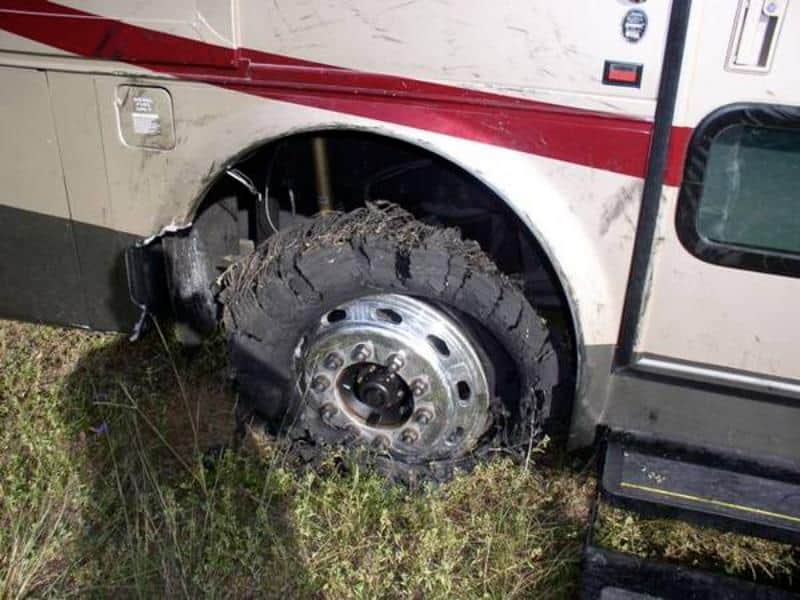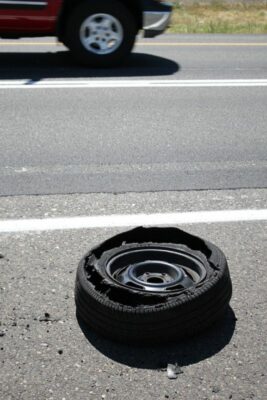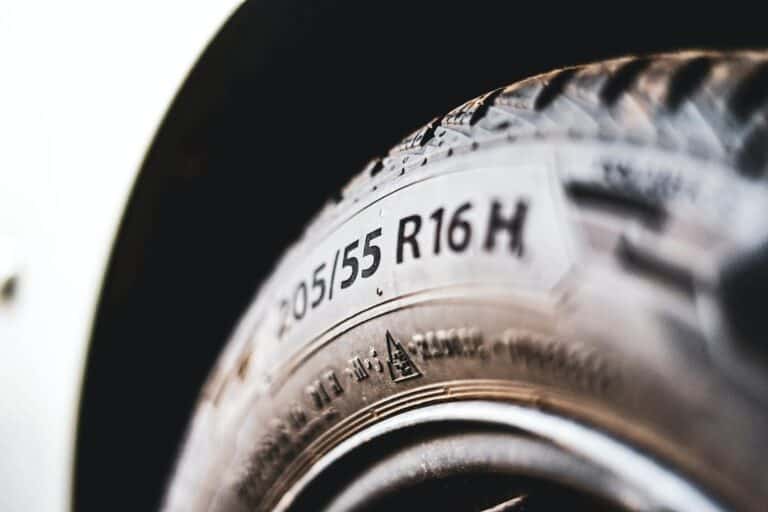Pssst … Missed Part 1 of the series? Read it here: Part 1 – the Ultimate Guide to RV Tires.
“I believe it to be the worst tire made in history.”
David Kurtz
“You cannot debate the defective nature of the G159,” he said. “There’s nothing to discuss.”
That’s what attorney David Kurtz said to Ryan Felton, senior reporter at Jalopnik.com.
In early 2018, NHTSA opened an investigation concerning the Goodyear G159 tire. The argument was that the Goodyear G159 tires were linked to at least nine deaths and 34 injuries – and allegedly many more.
The cause, the lawsuits said, was that the tires should never have been installed on RV motorhomes. The failure rate was as bad as one out of every 10 motorhomes.
Goodyear argued its innocence, blaming under-inflation and user error. Jalopnik, the automotive reporting website, relayed the saga.
I’m not going to tell you how the story ends. You can read the rest here.
Nor do I have any interest in brand-bashing. This isn’t an anti-Goodyear article. In fact, the modern Goodyear Endurance trailer tires are known as some of the best in the industry.
Instead, I want to lasso the elephant in the room.
Consumers, by and large, don’t trust RV tires.
I don’t blame them.
A Brief History of Blowouts
Let’s start with this sobering question: What happens if you have an RV tire blowout?
And that, dear readers, is why RV owners fear tire blowouts.
Shortcut Design
Here’s the straight-up truth, guys: For a long time, RV manufacturers were lax about weighing their units, documenting weight changes, considering all safety factors, etc.
- Like assuming that an RV’s weight was equally distributed side-to-side (almost never true, by the way).
- Not allowing for a reasonable amount of cargo.
- Or specifying tires that were juuuuuust baaaaarly strong enough, at their maximum inflation pressure, to support the GVWR.
That’s just laziness. And watchdog groups like the RV Consumer Group caught on. Here’s a sobering article from RVSEF about the all-too-common problem of overloading.
Finally, the industry began to pay attention – especially after getting slapped on the wrist by NHTSA!
Code Changes On the Horizon
So in September 2017, the RVIA (Recreational Vehicle Industry Association) unveiled two new tire rules:
- RVs with tires larger than 13-inches must use radial-ply tires
- Manufacturers must specify tires so that tires have a 10% reserve capacity versus the GAWR (Gross Axle Weight Rating). And manufacturers cannot de-rate the axle more than 12%.
That’s a huge step in the right direction! Tires are no longer the weakest link in the support chain.
RV manufacturers are starting to take tire safety and weight rating seriously. Some are even individually weighing each unit as it comes off the assembly line!
And there are limits how much weight a dealer can add without issuing a new MCO. If you’re curious about federal tire and rim selection regulations, check out the FMVSS CFR here.
With that, let’s get into some common FAQ questions about RV tire life, service and maintenance.

What is Reserve Tire Capacity?
We’ve already talked a little about radial-ply tires, but what’s reserve capacity?
Say you have a tire rated for 2,000 lbs (CAPACITY) and it carries 1,500 lbs (LOAD). Your reserve capacity is:
(CAPACITY - LOAD)/CAPACITY x 100%
In your tire’s case, you have a reserve capacity of 25%. Nice job!
Prior to the 2017 rule revision, many RVs could skate by with reserve capacities of – well, almost nothing! Now, 10% is required for all new RVs and campers.
What’s better, according to Roger Marble of rvtiresafety.net, is 20-25%. This is similar to the tires on passenger vehicles, which is why they so rarely fail.
Does a Higher Tire Load Rating Make a Stronger Tire?
There’s this myth about tire load ratings that goes something like this: “The higher the tire load rating, the better the tire – stronger sidewalls and all that. That’s why it can carry more weight.”
Not exactly.
At a set air pressure, there is no difference in load capacity between an identical ST205/75-R15 D-rated tire and an ST205/75-R15 E-rated tire.
The difference is that the E-rated tire can survive a higher inflation pressure – and that’s what makes it stronger at that higher pressure! The pressure on the sidewall is the maximum pressure in that over-inflating the tire beyond the max psi will not increase its load-bearing capacity.
Some RV Tires Rules of Thumb
- Always replace tires in pairs! This is for many reasons. Tires change size as they age and heat-cycle.
- Don’t mis-match tires. You don’t want to mix n’ match sizes, tread patterns, etc.
- Tires in multi-axle applications suffer severe lateral forces. Make sure all tires are the same size, load rating, and same pressure!
- If your rig has two axles and only one has brakes, the better tires should go on the braked axle.
- Generally, you don’t need to balance or rotate tires on towable campers. Motorhomes and vans are an exception.
- Use the star pattern and the factory-spec torque when replacing a tire. Check the lug nut torque before every trip. Here’s a good video from Keystone.
What About “China Bombs”?

On certain online forums, the rumor mill suggests that all trailer tires made overseas are “China bombs” waiting, watching … wanting you to pass a “50 Miles Until Next Services” sign. Then they’ll explode like a July 4th firework.
This is not true.* In fact, almost every single trailer tire sold in the U.S. isn’t made here, even if it’s sold by a US-headquartered company.
The big exception to this rule is BF Goodrich Endurance tires. As of this writing, I think all other big tire companies, like Cooper and Michelin, have quit making domestic trailer tires.
If you’re curious about the source of your tires, check out the DOT code on the sidewall. Plug that code into an online lookup service, and you can see exactly where your tire was manufactured.
*This is not to say there aren’t crummy tires produced overseas. There certainly are, and if you purchase a bargain-basement RV, you had best check your tires twice.
But the country of origin isn’t the metric you should use to rate tire quality.
What Is My Correct Tire Pressure?
There are two schools of thought on tire pressure.
Mr. Bob, from down the street, says to “let a little air out” of your RV tires or trailer tires to improve the ride quality. Less bounce, he says.
If you want to cause your friendly neighborhood engineer to have epileptic fits, then sure, go ahead. As we learned in Part 1: The Ultimate RV Tire Guide, tire load varies with pressure.
Deliberately underinflating your tires to improve the ride quality at the expense of reserve capacity is dumb. What mostly determines your ride quality is your suspension and tare weight. Tire inflation has minimal impact for most campers.
And just listen to all the problems underinflation can cause:
- Excess heat buildup
- Uneven tire wear
- Poor cornering and handling
- Decreased fuel efficiency
- Reduced tire life
- The notorious blowout!
This is serious stuff, guys. Underinflation kill tires. Some manufacturers even insist that if their tires are run 20% lower than maximum pressure at load, they have to be professionally inspected and re-mounted!
As a rule of thumb, you should only decrease your inflation pressure if the tire reserve capacity is in excess of 35-50%.
Why Are My Tires Only Rated for 65 mph?

Aka, how fast can I really tow my camper?
This is a simple question – but don’t worry, I’ve complicated the answer.
Half the internet will tell you that ST tires are rated for 65 mph – period. If you tow faster than 65 mph, you will build up excess heat. This will ruin the lifespan of your tires, wear down your hub bearings and cause blowouts.
The other half insists that the 65 mph rating is based on testing and load standards, not in-service durability. After 2015, most ST tires now come with a maximum speed rating.
So, they reason, cruising at 80 mph on M-rated tires is perfectly reasonable.
Both sides miss the point.
For one thing, many state laws cap trailer towing speed at 55 to 65 mph. So yes, that cop could definitely pull you over for “Just keeping up with traffic, officer!”
For another thing, slower driving is safer driving. The faster you drive, the longer it takes to brake – exponentially!
Again, as my favorite RV tire expert Roger Marble explains, you should think of speed ratings as a redline test.
Just because your $20 OEM tire survived 75 mph in perfect test conditions without exploding does not mean you should tow your travel trailer 75 mph across the country on I-80!
We could delve into the murky mathematical depths of tire speed testing and the relationship between speed, pressure, heat and load, but in the words of Inigo Montoya:
“Let me explain. No, there is too much. Let me sum up.”
As speed increases, as a rule, weight should decrease. Otherwise, your tires will heat up and you’ll risk belt separation (aka blowout).
But chances are, if your tire reserve capacity is between 0-15%, you don’t have this option anyway.

What Are Some Common RV Tire Sizes?
Common RV and trailer tire sizes include:
- Boat trailer: 5.30×12 and 175/80-13
- Utility trailer: 205/75-R14 and 205/75-R15
- Travel trailers: 205/75-R15, 225/75-R15, 225/85-R16
- Fifth-wheels: 235/85R16, 225/70-R19.5
- Motorhomes: 255/70-R22.5
Now, most light- to medium-weight towables will use 15 inch tires. It’s an industry bias.
- Affordable and sold everywhere
- (Usually) sufficient ground clearance
- Suited for highway speeds
- Suited for light “soft roading”
- Compatible with common industry-standard hubs, axles, bolt patterns, etc.*
*This is an important point. The moment you move to 16-inch tires, that normally means new bolt patterns, probably new hubs and brakes, maybe even new axle. Unless there’s an overriding reason to use 16-inch tires, most towables try to stick with 15-inch tires.
P.S. You won’t see a lot of triple-axle RVs. We could build ‘em, but who would come? Only the roughest, toughest heavy-duty trucks could tow something that heavy. So the only triple-axle RVs you’ll see are brand flagship models.
The Big Takeaway for Safe RV Tires
If there’s one thing I want you to remember from this post, it’s this:
Aim for 15%+ reserve capacity for your RV tires!
This may require new tires. If so, do it. It’s worth it.
If you’re driving an older rig and you don’t know your tire reserve capacity, you really owe it to yourself and your family to weigh the load on each tire, when your RV at maximum load, and make sure you’re in the safe zone!
RVSEF partnered with Bridgestone to even bring you this awesome info chart. If you’re on the fence, just go watch that rollover video again.
Check out:
… for critical information about how to prevent a tire blowout.
Leave a Reply